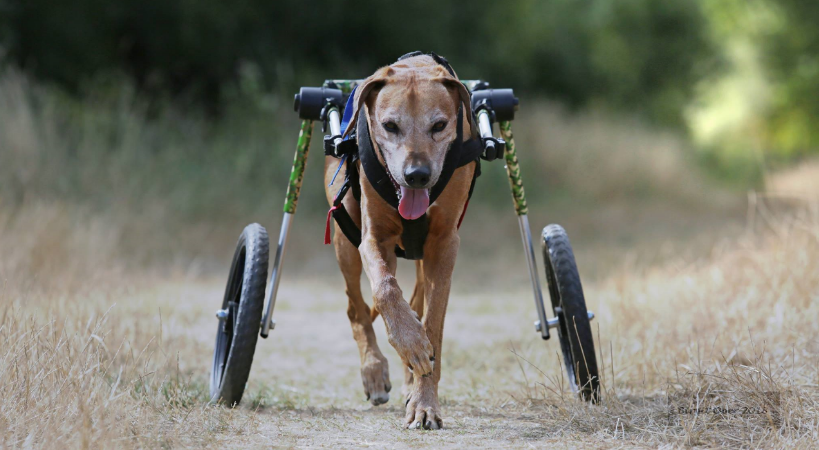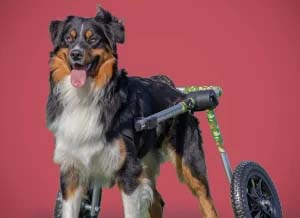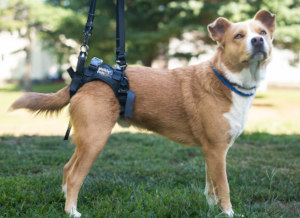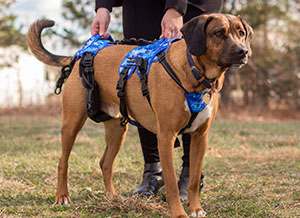- September 14, 2023
Senior Dog Exercise | Joint Health & Vitality

Aging dogs often experience various health issues and age-related changes. Many develop mobility problems, usually due to the wearing of the joints and muscles. Your dog may start walking more slowly instead of sprinting to get somewhere.
If you have a dog that gets a good amount of exercise, you notice their mobility problems due to aging easily. Some dogs don’t run or jump as often as they used to or don’t want to get outside for exercise or playtime. You may have to adapt your walking routes so your dog isn’t climbing as many hills or walking along rough areas.
Even though your dog may not want as much exercise as before, playtime is still a beneficial way to ensure you manage weight and assist in overall health and happiness. As responsible dog owners, providing your pup with the best care even when it gets older is necessary.
If your aging dog is finding it challenging to keep up with activity due to joint and mobility problems, you may wonder if there are safe exercises to ensure it stays active. There are still plenty of ways you can have your dog get exercise with some more low-impact activities that will help preserve health and vitality.
The Health Symptoms of Senior Dogs
Besides recognizing that your dog is older, some signs indicate it may be time to switch up the exercise routine. Many senior dogs can experience a variety of symptoms, many of which include the following:
- Lumps or bumps on the skin – Many senior dogs get spongy lumps that protrude from the skin, called lipomas; these are mainly fatty tumors, and you have no reason to be concerned, but you can talk to your vet if you are worried.
- Lethargy and exercise intolerance
- Sleeping more often during the day
- Reduced appetite
- Increase in thirst
- Disorientation or trouble with balance
- Smelly breath
Unfortunately, severe health issues like cancer can affect older dogs. Many dogs also experience urinary incontinence or develop heart murmurs that cause coughing or difficulty breathing.
Any of these symptoms and signs can cause you, as the dog owner, to become worrisome. The expert veterinarians and animal technicians at Bond Vet state that while many of these signs are common in aging dogs, you can always contact your vet or bring your dog in for an examination, just to be on the safe side.
Low-Impact Exercises
Being mindful of your aging dog’s limitations means that you should look into incorporating more low-impact exercises. Here are some of the best ways to ensure your pup still gets the training it needs each day without pushing too hard.
Walking
Walking your pet daily is essential to ensure overall health regardless of your dog’s age. Many dogs need at least one longer walk every day, and you can break it up a little bit by taking some shorter walks. Allow ample time for your dog to stop and sniff around for a break during your walks.
Pay attention to your dog’s pace as you walk. If your dog suffers from more issues in the hips and joints, monitor the affected areas after each walk to ensure no inflammation, swelling, or flare-ups causing limping.
Dog harnesses and chairs can also be helpful to keep your dog mobile. Talk to your veterinarian about what options can help a dog with more severe mobility issues and what products are best.
The weather can also impact your senior dog since extreme heat or cold can feel more sensitive. Consider investing in some outerwear if your dog is more susceptible to cold or putting something on the paws to help protect from the heat on the blacktop or pavement.
Go for a Swim
Swimming is one of the best ways to exercise your dog with low impact since it’s very easy on the joints and muscles. You can get your dog an effective workout without putting any pressure on their bones.
If you own a pool, all the better, but don’t think that there aren’t options without a pool in the backyard. Check out areas around you with a beach, lake, or pond where you can have your dog go for a swim.
If you haven’t ever taken your dog swimming, your dog may not want to go in the water. Don’t try and push your dog to swim since it may cause more injury with your dog in a hurry to get out. Introduce swimming slowly, and encourage your dog to take an interest by going in yourself.
If your dog likes to follow you, it’s likely that eventually, they may come to you and swim. It may help if you get your dog a life vest to help it feel safe and secure in water.
If you can’t entice your dog to swim, try getting a walk in a shallow area that your dog is willing to go in, where the water doesn’t go high. It will still provide low-impact resistance and can also help cool your pup off on a hot day.
Mental Stimulation
Mental exercises can also impact your senior dog’s physical health, so they are equally essential to include. Nose work, for instance, is a great way to entice your dog to do some moving around and light digging by hiding treats or toys around the house.
Take the mental stimulation a step further by making a game out of it. Consider putting a treat under a cup with three other cups and have your dog find the one with the treat. Or keep it simple and just put some treats around the house while your dog naps to find later.
There are plenty of interactive dog toys and puzzles you can invest in to help with this task. If you have a curious dog, these are another great option to provide some nose work that involves a bit of physical activity.
Learning Commands
The saying “You can’t teach an old dog new tricks” is so far from the truth! You can work with your senior dog to help it learn new commands with simple repetition and praise with treats or toys.
Keep your commands simple and straightforward; don’t try and have an aging dog perform tricks that involve a lot of running or jumping. Instead, consider teaching something like “roll over” if your dog already knows “lay down” to add and enhance learning a new command.
Caring for Your Aging Dog
Ensure you don’t overexert your dog with exercises that last too long or are strenuous when aware of mobility issues due to age. Skip the running or hiking, focusing on shorter walks and quality play sessions.
It can be helpful to ask your veterinarian for recommendations on what low-impact exercises or physical activity is best for your senior dog. It is possible that depending on the severity of health problems, there may be options for surgery, joint replacement, or rehabilitation.
There are also some helpful supplements for joint support and flexibility. Care for your aging dog by ensuring you still supply plenty of good exercise to manage overall health and vitality for a long, happy life together.
Related Articles:
Tags
What do you think?
Related Articles

New Puppy Checklist: Gear You’ll Need for Your New Dog
Getting a new puppy is really exciting, but before you welcome them home, it’s important to prepare your space for them. Since puppies need a

How Big Do Mini Poodles Get? Vet Reviewed Average Weight & Growth Chart – Dogster
The information is current and up-to-date in accordance with the latest veterinarian research. Learn more » When you buy a Miniature Poodle, you might not

Can Police Dogs Smell Nicotine? Vet Verified Facts & Info – Dogster
The information is current and up-to-date in accordance with the latest veterinarian research. Learn more » While cigarette sales have been declining steadily for decades,

How Old Is 5 in Dog Years? Vet-Approved Guide to Each Size of Dog – Dogster
The information is current and up-to-date in accordance with the latest veterinarian research. Learn more » A common method for calculating a dog’s age is




